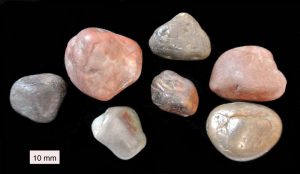
Why do animals eat rocks? While doing no favors to our teeth, eating stones actually helps some animals to survive. Many animals need to do this reasons for this: to help digest food or to aid in mobility. Those animals have two different stomachs; one for stones and one for food.
The rocks that animals consume are called gastroliths which literally translates to “stomach stones.” Gastroliths can be found in a range of animals including birds, reptiles, fish, insects, and even some mammals. Any type of stone can become a gastrolith; it just has to have been swallowed to join that club.

Why Do Animals Eat Rocks – Herbivores
What is an herbivore? It’s an animal that primarily eats plants. (Did you know that rocks and minerals play a role in plant growth?) So why do animals that eat rocks include herbivores? Though animals that eat stones are not all herbivores, those that are, have a special reason to consume rocks. Plant material is made up of cellulose. Cellulose is one of the most abundant, yet hard-to-digest materials found in plant material.
Cellulose is difficult to break down inside the body with only stomach acid. Why do animals eat rocks? Because stones inside an animal’s gizzard help to break this material down further before transferring it to a second stomach for additional digestion. This process smooths the stones over time. Many animals then regurgitate these smooth stones in favor of more jagged ones to help with the breaking down of food.

Why Birds Eat Rocks
Birds are the most common group of animals that eat rocks. These rocks aid in their digestion. Folks who raise birds are familiar with this as many supplement their feathered friends’ diets with grit, which are very small stones with uneven, blunt edges.
Birds don’t have teeth, or stomachs like mammals, instead, have a gizzard which is a muscular mass attached to their version of a stomach. The gizzard is where their food is ground up and mashed with the aid of the stones that they have swallowed.
Most avian consumers of stones are ground-dwelling or flightless birds. Chickens, turkeys, ostriches, and even penguins routinely swallow jagged little rocks while they are out and about foraging for food to help their digestion. Research has found that in ostriches, between one-fifth and one-half of their stomach contents are gastroliths.
These account for about one percent of the bird’s total body mass. It is speculated that the ratios and percentages are similar for other birds too (at least the ones that eat rocks).
There are some flying birds though that have been documented to be stone-eaters.
Crows and parrots are known to eat small rocks to aid their digestion. Some swimming and flying birds like ducks are also known to eat small grit-stones to help them break up their swallowed food. It is very likely that all birds swallow stones in some capacity to help break down their food.

Tambako the Jaguar is marked with CC BY-ND 2.0.
Why Reptiles & Amphibians Eat Rocks
The need for birds to swallow rocks is pretty well understood. The same cannot be said though for reptiles. The prevailing theory for decades was that for swimming reptiles like crocodiles, swallowing rocks helped with their buoyancy. Given that they like to hover just below the water’s surface, this might be a plausible reason. A bellyful of rocks could help weigh themselves down enough so they don’t float all the way up to where they can be easily seen by their prey.
Much recent research about why do animals eat rocks, however, has suggested other hypotheses for this behavior in reptiles. Scientists have found that gastroliths make up less than two percent of the body mass of reptiles. They calculate that for the gastroliths to have the previously believed effect of achieving buoyancy, that number should be more than six percent of the animal’s body mass. The act of breathing, filling, and emptying their lungs with air, has more of an effect on buoyancy than the two percent of their body weight comprised of stones.
Current speculation about why do animals eat rocks is that the swallowed rocks help to stabilize the reptiles’ bodies in the water, reducing the tendency to roll from side to side. Though not reptiles, frogs eat rocks too.
Like birds though, the hypothesis is it helps them break up the insects they eat to get more nutrients from them. Earthworms are another animal that consumes rocks. Their internal digestive muscles, along with teethlike structures known as “grinders” break up plant material so that nutrients can be extracted from them.

Why Do Animals Eat Rocks – Sea Life
A variety of sea life eats rocks. Fish, clams, seals, and even whales are known to eat rocks, though in some cases it is believed to be inadvertent. Like crocodiles, it was once thought that sea lions, seals, walruses, and whales swallowed rocks to make diving easier.
Like other hypotheses that have arisen in recent years, the thinking for these sea creatures is that since many find their food on the ocean floor, they inadvertently scoop up rocks while scooping in on their food. This is seemingly more probable than swallowing rocks to help them dive.
The problem with the rocks as a diving aid hypothesis is that they would have to swallow huge rocks to make a difference. There is no evidence that they seek out and swallow big, heavy rocks.
Several species of bottom-feeding fish are also known to eat rocks, though again, it is not entirely known if this is intentional to aid in digestion, or accidental consumption while grabbing food off the seafloor. Other possibilities have arisen to explain this phenomenon in swimming mammals.
Alleviate Hunger
It is possible that some of these, and possibly other animals that eat rocks, do so to help alleviate hunger. Taking up space in their stomachs could potentially make them feel more full. Another conjecture is that they, like birds with their gizzards, swallow rocks to help their digestion (sans gizzard) and to break down the wide range of items that they may accidentally swallow.
One of the more unusual sea-dwelling rock eaters is a type of clam found in the Philippines, Lithoredo abatanica. The name roughly translates to “rock shipworm from the Abatan River.” Many would not recognize this animal as a clam.
It is fattened, worm-like, translucent, at least four inches (10 cm) long, with a shell complete with shovel-like projections. It is not akin in either appearance or bloodline to the familiar Quahog or Atlantic type of clam, but instead is a member of the shipworm family. These clams eat wood, but the newly discovered Lithoredo abatanica eats limestone, not wood. It burrows into rock and excretes sand. It is not yet known if these creatures actually derive any nutrition from these rocks.
The consumption of gastroliths by animals is a more common practice than most people would realize. Whether it be for digestion (with or without a gizzard), buoyancy, diving, deriving minerals, or feeling full, it is a widely practiced behavior in the wild animal kingdom. The next time you see a small, unassuming, round stone on the ground, it may well have been on quite a journey inside of any number of animals before finding itself at your feet.
This story about why do animals eat rocks previously appeared in Rock & Gem magazine. Click here to subscribe. Story by Chris Bond.














